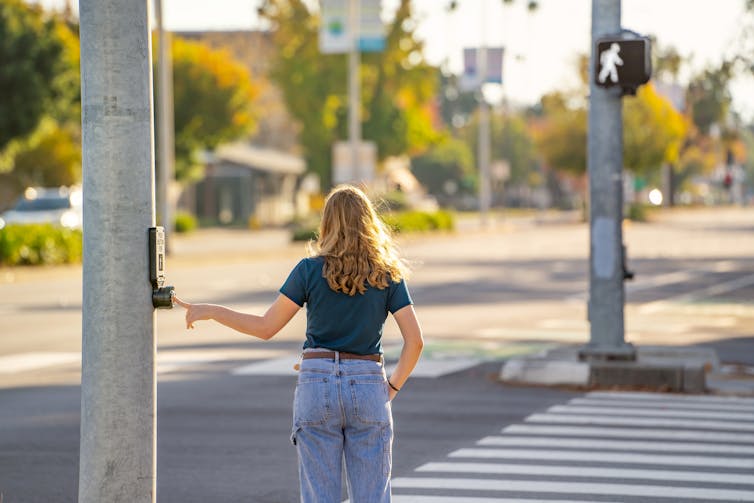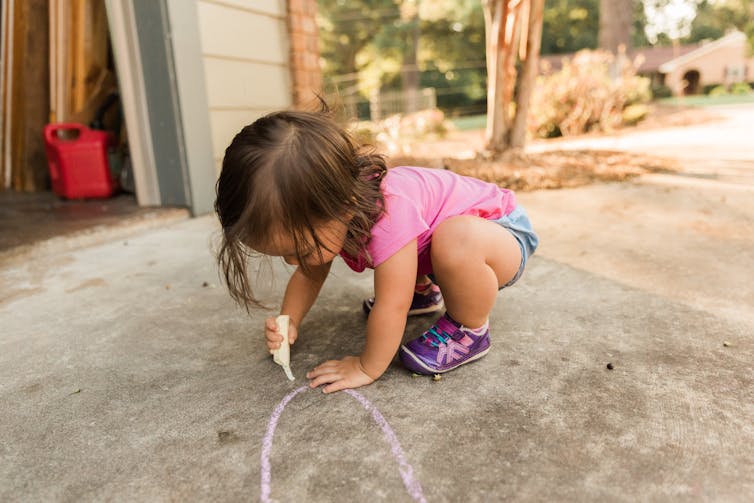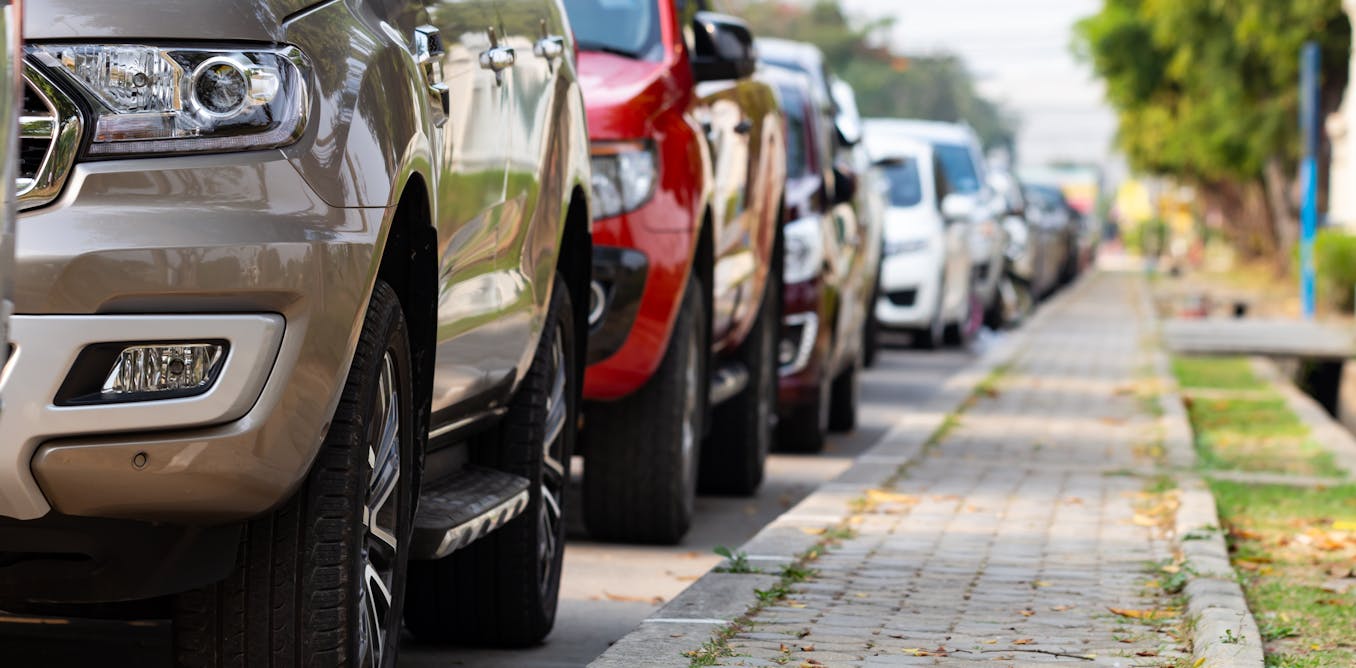We’re seeing more big cars on our roads, especially large wagon-style vehicles with a four- or all-wheel drive, known as sport utility vehicles or SUVs. For every passenger car sold in Australia, almost three SUVs are sold.
Vehicles such as pickup trucks, large utes, minivans and SUVs tend to offer more protection to their occupants than smaller cars. This is largely due to their larger mass and the way their structures are designed to absorb impact. For the drivers and passengers, this can mean a lower risk of injury in multi-vehicle collisions.
But those same attributes increase the risks to occupants of smaller vehicles, pedestrians and cyclists. The height of the large vehicle’s front end can intrude into the passenger compartment of a smaller vehicle and its greater mass can lead to more forceful impacts.
The invincibility perception
Surveys show drivers believe larger vehicles are safer. This has a major influence on deciding which car to buy (among other factors such as prestige and off-road capabilities).
The perception of safety could potentially lower a driver’s sense of risk aversion, leading to riskier driving behaviours, such as adopting less cautious hand positions on the steering wheel. SUV drivers more frequently drive with one hand (as opposed to a “10-2 o’clock” hand position), suggesting they feel safer than other car drivers.
Impact on collisions
A study from the Netherlands found a significant increase in fatality risk with heavier vehicles.
This has also been seen in the United States, where a study found a 500 kilogram increase in vehicle weight, which could mean the difference between an SUV and a sedan, correlated with a 70{e60f258f32f4d0090826105a8a8e4487cca35cebb3251bd7e4de0ff6f7e40497} higher fatality risk.
AlivePhoto/Shutterstock
The 2003 bumper height-matching standard aimed to reduce the severity of crashes between SUVs/pickup trucks and cars. By aligning the bumper heights of these vehicles, their bumpers would engage properly during a collision, improving the crash force distribution and better protecting occupants.
But it has had mixed results. It modestly decreased death risks in side-collisions but was less effective in head-on crashes. This suggests further safety improvements are needed to address vehicle-to-vehicle collision impacts effectively.
The likelihood of SUVs causing fatalities to drivers in other cars reduced from being 132{e60f258f32f4d0090826105a8a8e4487cca35cebb3251bd7e4de0ff6f7e40497} more likely for a collision with an SUV in the early 90s, to 28{e60f258f32f4d0090826105a8a8e4487cca35cebb3251bd7e4de0ff6f7e40497} more likely by 2016. Likely reasons for the decrease include implementation of the bumper height-matching standard, as well as improvements in vehicle design: the implementation of crumple zones, better side-impact protection and advanced safety features such as electronic stability control.
However, we haven’t seen similar improvements with pickup trucks, suggesting weight is a possible cause of the increased risk of fatalities.
What about pedestrians and cyclists?
Pedestrians are more likely to suffer fatal injuries in a collision with a large vehicle than a passenger car.
The design of these vehicles, particularly their higher front-ends, significantly elevates the risk. A mere 10 centimetre increase in front-end height can elevate the risk of pedestrian death by 22{e60f258f32f4d0090826105a8a8e4487cca35cebb3251bd7e4de0ff6f7e40497}, with impacts more likely occurring at critical injury points like the chest or head.

Iv-olga/Shutterstock
Studies have shown a correlation between the surge in larger vehicle sales, such as SUVs, and an increase in pedestrian fatalities in the United States between 2000 and 2019. Children are eight times more likely to die when struck by an SUV compared to lighter and smaller cars.
Researchers estimate that substituting larger vehicles with smaller cars in 2019 could have prevented around 460 US pedestrian fatalities that year alone.
Computer simulations have examined the impact of car accidents on the human brain of pedestrians, comparing the effects of being struck by an SUV versus a sedan. SUVs exert twice as much force on the brain as sedans when moving at equivalent speeds, significantly increasing the risk of severe injuries, even before direct head contact occurs.
Computer simulations have also shown that high-front vehicles cause pedestrians to hit the ground at higher speeds.
Cyclist injuries from SUV-related crashes have also been found to be notably more severe than those from car-related crashes, with a particular increase in the severity of head injuries for collisions involving SUVs.
This difference in injury severity is attributed to the design of SUVs, which are more likely to cause cyclists to hit the ground or to inflict injury.
Impact on driveway collisions
Large vehicles increase the risk of driveway accidents, particularly involving children aged under five, as their design often limits rear visibility.
An eight-year study from Utah identified 495 vehicle-pedestrian injuries, with 128 occurring in driveways. These accidents disproportionately involved larger vehicles such as SUVs, trucks and vans, due to their extensive blind spots.
The “Spot the Tot” public awareness campaign and similar initiatives aim to combat these incidents by promoting safety practices such as visual checks behind the vehicle before moving.

Handcraft Films/Shutterstock
The emergence and adoption of technologies such as backup cameras and parking sensors has markedly improved visibility, reducing blind zones by around 90{e60f258f32f4d0090826105a8a8e4487cca35cebb3251bd7e4de0ff6f7e40497}.
Despite these advances, the need for heightened driver awareness and precaution remains critical.
Stopping the vehicle arms race
With more and more drivers opting for larger vehicles under the guise of personal safety, they may inadvertently compromise the safety of pedestrians and other road users. For every fatal accident avoided by someone inside a large vehicle, there are at least 4.3 additional fatal accidents involving others.
Changing the trend towards bigger cars requires strong policy and (dis)incentives.
There’s currently a discussion about imposing heavier taxes and/or registration fees on SUVs and larger cars, particularly for their safety implications on others.
In some places, such as Paris, heavier vehicles are discouraged by tripling parking rates for cars over a certain weight.
But given the popularity of large vehicles, such policy change won’t be easy.



